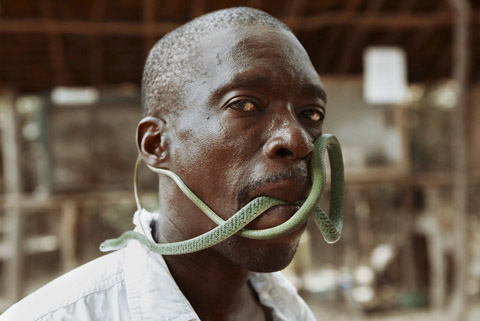In 2008 the photographer Jérôme Sessini started the Mexican project: a dive into the drug cartels war in Mexico. This compelling reportage, lasting two years, is a valuable document about the most dangerous cities in the country: Culiacan, Tijuana and especially Ciudad Juarez
-
tagged Jérôme Sessini
-
Grotesque yet utterly intriguing, Japanese photographer Yumiko Utsu’s work enthralls the viewer with playful constructions of fruit, dismembered sea creatures, vegetables and insects set against colorful tapestries. Her bizarre and humourous photo-art, revolving around food and animals, falls into the narrow genre of disturbing kitsch that could only come out of Japan.
tagged Yumiko Utsu -
Harta138: Panduan Daftar Situs Harta 138 Slot Online Terlengkap 2023
Harta138 slot gacor adalah platform judi online terkemuka. Temukan keberuntungan Anda di Daftar Situs Slot Harta138 portal slot online paling menguntungkan
via Harta138: https://wildplanetphotomagazine.com/
Earlier this month, TIME published A Syrian Tragedy: One Family’s Horror, a series of images shot by freelance photographer Nicole Tung. The images, shot in Aleppo as the Syrian city was under attack, portray civil casualties, highlighting how the war has torned apart families. For the past four months, Nicole has been documenting the uprising in Syria. Months before, she was in Libya, covering her first violent conflict at just 25.
In an interview with Photojournalism Links, she tells us more about her work in Syria, how she gained access to the country and what she’s seen there.
tagged Nicole Tungin Interviews -
The horrific journalism that’s going on surrounding my brother — and the scalding headlines and the pictures that were in the New York Post and The New York Times that my family had to see and endure, to see those pictures that were the most horrific pictures. They gave Osama bin Laden more respect and dignity than my brother, sprawled out over the — with blood coming from him. So I would just make a plea to everyone who’s out there that are reading these stories. There’s a family behind, grieving and dying for one of their own right now and we need all your support.
in Ethics -
I am not saying that there is no good to be had from the new technologies. Far from it. The new cameras let us make pictures that were never even imaginable a dozen years ago. But in all of that, in the rush to bestow the crown of technical achievement upon the head of digital photography, I think we risk losing a piece of the soul of all our work. And whatever each of us can do as individuals to get beyond the norm, the expected, the predictable, and the obvious that is what photography in the new century demands of us.
tagged David Burnett -
The family of Austin Tice, an American freelance journalist who has been reporting from Syria for The Washington Post and other news organizations, said Thursday that it has not heard from him for more than a week and is concerned for his welfare.
tagged Austin Tice -

His project L’Afrique materialized from an assignment in Africa from a French client. The project includes images from from Burkina Faso, Ivory Coast and Kenya but Jonathan plans more visits to West Africa/Francophone speaking countries in the future.
tagged Jonathan May -
This series, Middle Class Utopia, focuses in Austrian allotment gardens in and around Vienna, called ‘Schrebergärten’. These tiny gardens were invented in the late 19th century, mainly to provide space for the working class people to grow their own vegetables and fruits. Over the time, the use of these gardens changed and now they are mainly used for recreational purposes.
-

The New York Times has assembled a “Convention Storybook,” an online archive of the conventions. It is a look inside the two parties as they sought to articulate their platforms and positions as clearly as possible, without interference.
The “Convention Storybook” presents photographs by Stephen Crowley, Josh Haner, Todd Heisler, Doug Mills, Damon Winter, Mike Appleton, Travis Dove, Edward Linsmier, Luke Sharrett, Robert Stolarik, Max Whitaker and Jim Wilson. Michael Barbaro provided audio and it was produced by Nick Corasaniti, Jacqueline Myint and Cornelius Schmid
-

Picturing Everyday Life in Africa
Too often the subjects of images of Africa seem to be reduced to symbols — viewers do not encounter them as fully rounded human beings, rarely seeing journalistic images of the middle class, artists or the cultural heritage of African countries. Peter DiC
via Lens Blog: http://lens.blogs.nytimes.com/2012/09/17/picturing-everyday-life-in-africa/
I realized that I had to keep doing it, because there’s a constant barrage of imagery of misery, despair and hopelessness, and more than any of those things — helplessness, the idea that Africans need to be saved
tagged Peter DiCampo -
Thursday September 13, many news organizations published a photo of U.S. Ambassador to Libya Chris Stevens either dead or dying after a terrorist attack on the American consulate in Benghazi. The ethics Committee would like to add some thoughts to the discussion on the use of this image
in Ethics -
The Robert Mann Gallery in New York City recently moved to a new location and to inaugurate the space, they are hanging a retrospective of Richard Misrach’s landscape and fine-art photography
tagged Richard Misrach -
In a nutshell, it works like this. Social media platform ( think Pinterest, Facebook, Twitter) install an API on their site that allows to automatically recognize if an image posted belongs to a photo agency (Getty Images only for now). Upon recognition, the usage is either approved or denied. If approve, a license fee is charged.
in Copyright -

Looking Back on the Party Conventions
In his sixth and seventh installments of the continuing series “Smoke-Filled Rooms,” the Times staff photographer Stephen Crowley examines the recent presidential nominating conventions.
via Lens Blog: http://lens.blogs.nytimes.com/2012/09/14/an-eye-on-the-party-conventions/
In the sixth and seventh installments of the “Smoke-Filled Rooms” series, Stephen Crowley, a staff photographer at The New York Times, looks back on the conventions, striving to see beyond the restrictions, spin and control of the contemporary American political process. With an unorthodox presentation of photographs and text, Mr. Crowley examines the forces that influence the presidential campaign.
tagged Stephen Crowley -
When I look at the best documentary photographers in the world they are very selective about the information they put out. I don’t see Sebastiao Salgado on social media seven days a week. I don’t hear from Salgado every eight minutes. I know when I see something from him it has been well-planned, well thought out and is something I should pay attention to. We live in a world where people value photographers based on how many Twitter followers they have and that just isn’t smart. I love to blog. I’m not a proponent of the “you must post everyday” belief. I try to adhere to what I preach. Say something when I have something to say
tagged Daniel Milnor -
Maybe what we are seeing here is not just some digital post-processing completely out of control, but also the result of seeing almost each and every event on the big screen, re-imagined in some Hollywood form: Our thought of “It almost did not look real” is turned into a reality: It literally does not look real any longer.
tagged James Nachtweyin Ethics -

Four Decades of Photographing the Human Condition
In an exhibition in Paris, four decades of Peter Turnley’s photographs are on display from around the world, encompassing major conflicts and quiet, quotidian moments.
via Lens Blog: https://archive.nytimes.com/lens.blogs.nytimes.com/2012/09/12/forty-decades-of-photographing-the-human-condition/
As important as these images are to him, Mr. Turnley said, so too are the photographs he has taken of the more mundane moments in people’s daily lives. A great admirer of photographers like Robert Capa and Edward Boubat, Mr. Turley said he considered himself neither a war correspondent, like the former, nor a “peace correspondent,” as the latter was called. “One might say I am a correspondent of life,” Mr. Turnley said.
tagged Peter Turnley -
Embodiment: A Portrait of Queer Life in America is an ongoing photography / biography archive project by Molly Landreth. It is rich with imagery, honesty, humor, and individual stories. It’s a celebration of life and love, and it avoids the usual clichés.
tagged Molly Landreth
